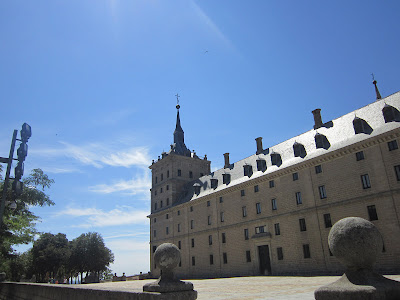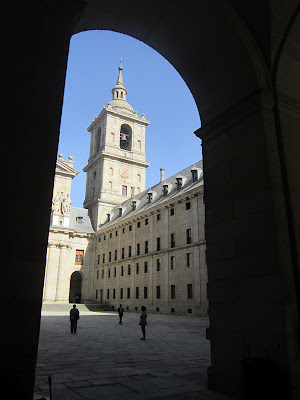Lo siento (I'm sorry!) I'm so behind on the blog. I've been writing throughout the trip, but then sometimes my internet connection is slow and it takes a long time to upload the pics and post the blog. But, don't worry . . I will keep posting because I have been writing in a notebook (old school style) about all the things I've been seeing. So . . . stay tuned!! We continued our tour of San Lorenzo de El Escorial by touring the centerpiece of the town, the peaceful monastery! This is the jewel of the town, and Dr. Sicius gave us an extensive historical tour of the monastery. He told us how Philip II had the monastery built, but that he was worried that he wouldn't see its completion. It took 20 years to build; however, Philip II did live to see the finished product. This monastery is the largest granite building in the world. And, this is easy to realize because our tour took about 4 hours, but I love going through this monastery. First, I will show you some pictures of the monastery and the beautiful Spanish sky. Again, remember that this is the walk that the students and I have every morning as we go to class. Bonito!
In the picture below, you can see the university to the right.
As we tour the monastery, there are security guards in every room (and Jose, one of our students, makes friends with each and every one of them). However, you cannot take pictures in most of the rooms of the monastery. And, as we've been discussing in class, we don't want to be those "tourists" who are sneaking pictures. But, to give you a sense of the amazing things we've seen, I've put a few professional images up. The picture below is one of the most amazing parts of the monastery, the Pantheon of the Kings. Here all of the kings of Spain are buried (and their wives, if the wives had sons). Again, I did NOT take this picture; it is a professional image from google images. But, so that you can imagine what it feels like here . . . you descend down many many steps, and there are signs asking you to remain quiet and respectful as you come into the room. On the way down the steps, you go past a door on the left and the right which are the drying rooms . .where the body dries out before being placed in the casket. Then, you enter this beautiful room that is very very very cold. Dr. Sicius told us that 500 years after one king died, the casket was opened, and the body was completely preserved. So, it is quite an odd feeling to imagine that you are surrounded by the completely preserved bodies of the kings of Spain in this room. Very interesting!
On the tour of the monastery, after you leave the Pantheon of Kings, you see several other rooms that house the caskets of royalty. However, there is one casket that just blows my mind. When I see it, I can't really believe that I'm seeing it, and that is the casket of Don Juan. Yes, the Don Juan! I did not take this picture below; again this is an already existing image. As you can see below, there is a sculpture of Don Juan, lying as if he were in the casket, holding his sword. It is difficult to see in the image, but on his fingers are many many rings. These rings are supposed to represent all the female lover that he had, because of course everyone has heard that Don Juan was the ultimate Romeo!
There is quite a bit of amazing artwork in the monastery because Philip II was a great collector of art. My favorite piece of art in the monastery is a painting of Doubting Thomas placing his hand in Jesus' wounds. More info on this later; I'm looking for the image online to show you, but I haven't found it yet.
The next picture below shows the garden of the monks . . this is a great place to walk through. It is so peaceful. Marcela even took her students here during one of her classes to do a guided meditation.
Group picture time! The students love it when I call for a group picture (sarcasm in that last statement in case you can't pick that up in written text!)
And, here I am in a picture with my next-door-neigbors, Rosa and Samara, treasurer and president of the Psychology Club respectively.
This is the view from the garden of the monks! Hermoso! Feel free to correct my espanol if I'm using these words incorrectly.
Next we are walking back through the monastery to go to the iglesia (church) and then the library!
Quick pic of the students as they are walking into the center of the monastery that leads into the church. That is Rosanna front and center (Psychology club Vice-President . . we have the Psychology club well-represented in Spain this year!)
Below is a picture of the front of the church.
At the very end of the completion of the monastery (20 years later), the final tiles that were placed in the roof that were put in the shape of a cross. Do you see it in the picture below?
More images of the church below.
Last, but definitely not least, we toured the library at the monastery. This library is amazing and Dr. Sicisu taught us that it is the MOST important library in the world for Hebrew and Arabic texts. In fact, this library has the OLDEST Hebrew text in the world. We couldn't take pics in the library, but I added a professional image below so that you can get a glimple of the beauty of this library. The ceiling represents the many academic disciplines like philosophy, mathematics, etc.
And, then in the picture below, after the tour, everyone has gathered at La Chistera to rest their tired feet! La Chistera is owned by Adolfo, long-time friend of Dr. Sicius and a huge help to us on our trip. This is the hang-out for STU Summer in Spain!
Below is a picture of the 3 guys on our trip: Jose, Juan, and Nico in the middle!!!
Adios for now. Stay tuned . . . I have quite a few drafts; I'm just waiting on pics to load!



















Um no comment on the no comments. :) It looks like you are having a great time. Or should I say it looks like you were having a great time since these events are LONG GONE. Blog content A- (lack of incriminating pictures lost half a letter grade) Timliness of assignment. D
ReplyDelete